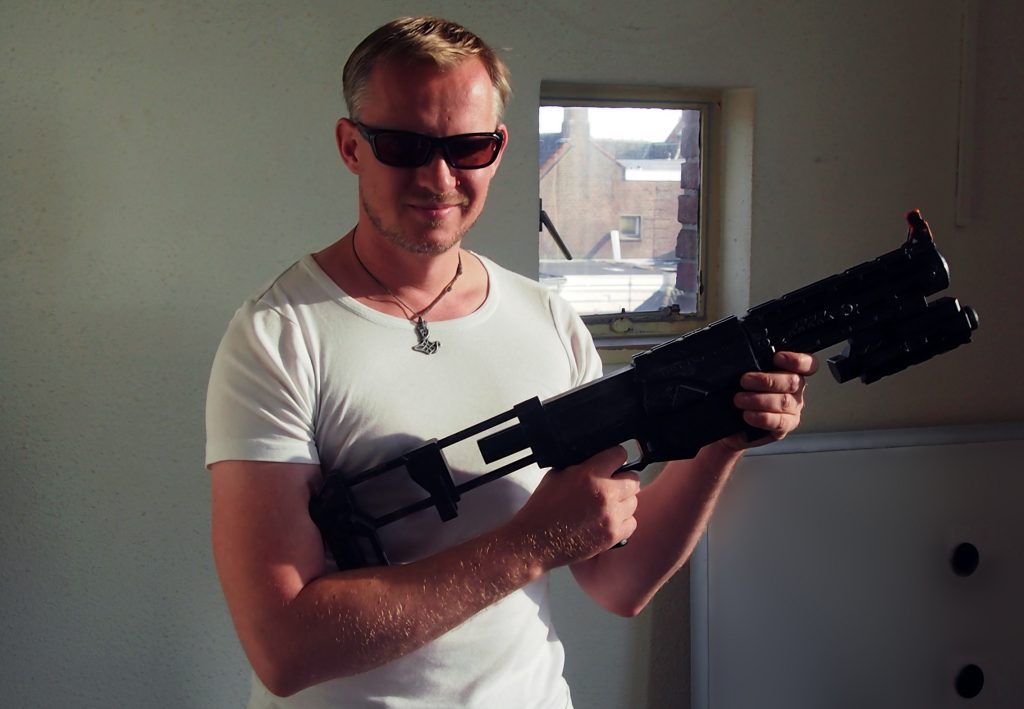Current post: Introducing: Ite Teune, Senior Biology Scientist

“That right there makes designing creatures so awesome, sometimes they turn out to have really cool properties we did not decide to give them, but that are a consequence of their biochemistry.”
“I am Ite Teune, chief biological scientist at Blue Falcon. In daily life, I am a science teacher at an innovative high school, where I teach biology, chemistry, and engineering. My role at Blue Falcon is to embed the science in the fiction, particularly when it comes to creature design, internal biochemistry, planet ecology, and a large part of the technology, such as spaceship design, weapon designs, and an aesthetically pleasing skyline of cities.”
How did you come to work on ‘The Coalition’?
One of my now-colleagues shared a Facebook post of the CEO, who was looking for a biologist with a knack for sci-fi. I responded to that post, and one week later we were bouncing ideas back and forth.
What’s it like working at Blue Falcon?
Working at Blue Falcon feels like brainstorming in a theoretical biochemistry lab that also has a workshop for theoretical engineering. There is a very creative atmosphere, reminiscent of the Google Netherlands headquarters in Amsterdam. We can work on whatever we feel like working on, we have no fixed working places, everyone can constructively comment on everyone’s work, and every day, during lunch, there are Nerf gunfights like the Battle of Coffeyville, KA.
From what you can discuss, what is the coolest thing you’ve worked on so far?
The two absolutely coolest areas I’ve been working on until now are the realistic biochemical pathways of almost all creatures we have designed so far, and a scientifically plausible way of traveling through the vastness of space. Both avenues of research have many challenges to overcome and it is a very intellectual challenge to ‘get it right’ without cutting corners.
What are you most excited about working on in the future?
I am very much looking forward to seeing the spaceship artwork. This, for me, is where science fiction truly comes alive. Although I feel it is a common misconception that all sci-fi revolves around space, spaceships do increase the scope of the narrative by several orders of magnitude. And within this, there are many different ways to generate the slightly dystopian atmosphere that we are aiming for. This will be the backbone of the look and feel of the Coalition. It will definitely not be all about spaceships and zany aliens. Star Trek and Star Wars, for example, are doing a great job at this, and I have a soft spot for both, but they do not possess the Byzantine mysticism that Frank Herbert’s Dune conveys, nor the gritty realism of the reimagined Battlestar Galactica by Ron Moore. We are aiming for realistic sci-fi in a universe past the exuberant stage of exploration, with a rich history of successes and failures where the moral and ethical bankruptcy of large corporations runs all known worlds from behind a thin veneer of democracy.
With what kind of unique challenges and rewards does your position provide you?
Tough one. The unique challenge is, to paraphrase Gene Roddenberry, to boldly go where no one has gone before. We are creating a universe different from anything that has ever been created from scratch, going so far as to design and simulate all stars, planets, and moons to make sure everything we write is firmly rooted in science. For many astrobiological problems, we have had to calculate many things, often deviating from the original plan, simply because some ideas are scientifically impossible. And sometimes, calculations match so nicely with original ideas, that one has the feeling it just had to be.
Crazy creatures are a staple for (pen and paper) RPGs, will ‘The Coalition’ continue that tradition?
Absolutely! Players will have a rich selection of abominations to choose from to create their characters. Biology follows certain rules, and all creatures on Earth have evolved to be able to survive on Earth. On other planets, almost everything will be different from Earth, so evolution will have produced different creatures.
How much are you basing ‘The Coalition’ species on existing biology?
Many theoretical biologists agree that carbon is the only suitable basis for life forms, and Miller’s experiment, for example, show that inorganic compounds can form organic molecules when subjected to energy. Simple compounds like water, ammonia, methane, nitrogen, etc will form amino acids, carbohydrates, and even nucleic acids. Recent astronomical observations have confirmed chiral organic molecules in interstellar gas clouds. It is therefore logical that life forms will contain these molecules, which will make them recognizable. The biochemistry of these organisms was absolutely thrilling to design. I worked with ideas from our CEO and started to see if those ideas were biologically possible or not. For example, we have five different ways of transporting and distributing oxygen throughout a creature, all of them scientifically proven and applied to their corresponding biological niches.
What’s the craziest thing you came across while researching biology for ‘The Coalition’? (and did you use it in some way?)
There was this one time where the question came up if it was possible to have blood that could change color to make a creature more translucent, allowing it to blend in with its surroundings more easily. Turns out, there are respiratory metalloproteins that can actually do this. And as an added bonus, these creatures turn out to be immune to carbon monoxide poisoning. That right there makes designing creatures so awesome, sometimes they turn out to have really cool properties we did not decide to give them, but that are a consequence of their biochemistry.
[…] off the second. Our building became pink over night, including some of our windows. And our own Ite Teune became a proud father! And we’re excited to continue, going the extra mile as per usual, but […]